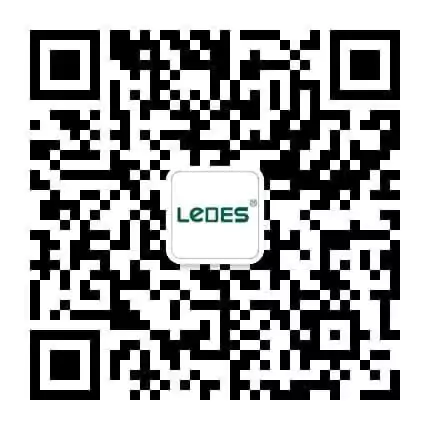
목차
NEC 소개
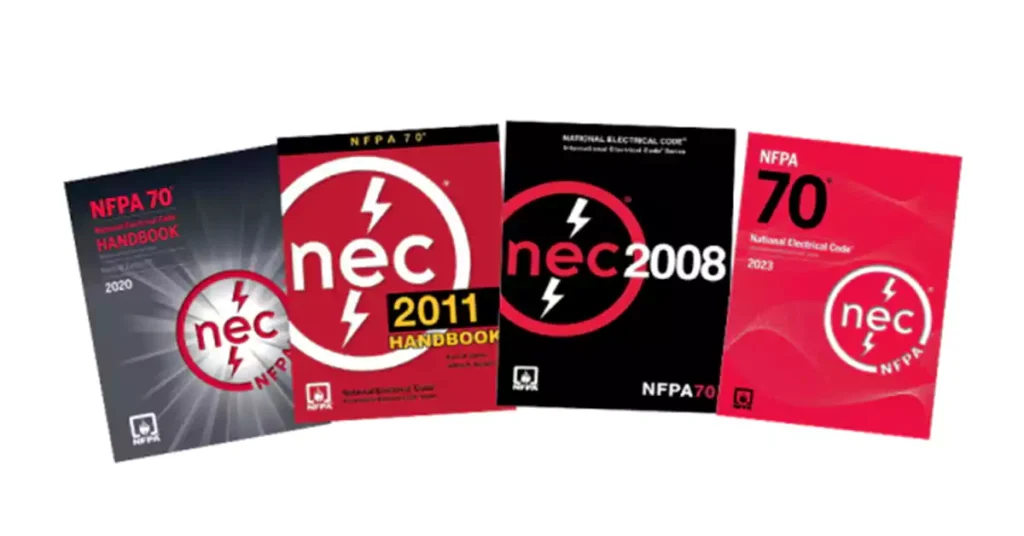
미국 전기 규정(NEC, National Electrical Code)은 공식적으로 NFPA 70으로 알려져 있으며, 미국에서 전기 배선 및 장비의 안전한 설치를 위한 벤치마크 표준입니다. 미국방화협회(NFPA)에서 발행하는 NEC는 연방, 주 및 지역 차원에서 널리 채택되고 시행되고 있습니다. NEC는 주거, 상업 및 산업 시설 전반에 걸쳐 전기 설계, 시공, 검사 및 유지 보수의 기본 규정으로 사용됩니다.
NEC의 목적
NEC의 주요 목적은 전기 위험으로부터 사람과 재산을 보호하는 것입니다. 이는 재료, 배선 방법, 접지, 과전류 보호 등에 대한 지침을 포함하여 안전한 전기 설비에 대한 최소 기준을 제공함으로써 달성됩니다. NEC는 연방법원은 아니지만, 일반적으로 주 및 지방 관할권의 채택을 통해 시행되며, 건축법규에 통합되는 경우가 많습니다.
참고사항: NEC 코드에 대해 더 자세히 알고 싶으신가요? 여기를 클릭하세요. 국가 전기 규정에 대한 완벽한 가이드NEC의 중요한 부분을 설명합니다.
PVC 도관과 그 이점에 대한 이해
PVC 도관(또는 폴리염화비닐 도관)은 현대 건축에서 가장 널리 사용되는 비금속 전기 배선관 중 하나입니다. 다재다능함과 신뢰성을 인정받은 PVC 도관은 다양한 주거, 상업 및 경공업 분야에 적용 가능하도록 미국 국가전기위원회(NEC)의 승인을 받았습니다. NEC에서 관리하는 가장 일반적인 두 가지 유형은 다음과 같습니다.
- 강성 PVC 도관 (PVC 일정 40 및 일정 80) – 다음에 해당됨 국립전기기술원 제352조
- 전기 비금속 튜브(ENT) – 다음에 해당됨 국립전기기술원 제362조
강성 PVC 도관(일정 40 및 80)
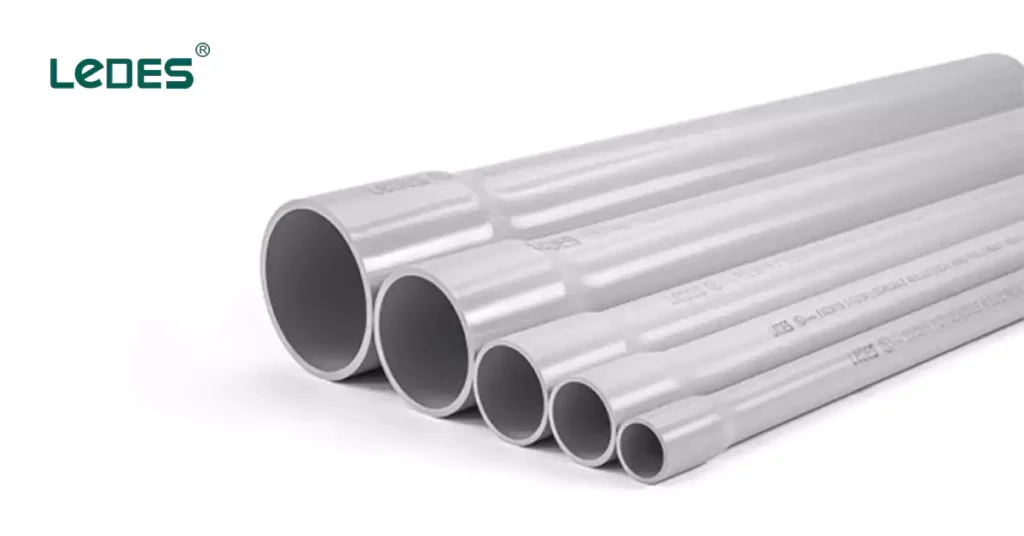
경질 PVC 도관은 내습성, 내식성, 난연성을 갖춘 견고한 벽의 파이프입니다. 일반적으로 지하 시설, 은폐형 시설 및 노출된 옥외 환경에 사용됩니다. 대부분의 주거, 상업 및 산업 분야에 널리 사용됩니다. Schedule 40과 Schedule 80의 차이점은 벽 두께에 있습니다. Schedule 80은 벽 두께가 더 두꺼워 통행량이 많거나 노출된 공간에서 더 높은 기계적 보호력을 제공합니다.
주요 특징:
비전도성 및 내식성
직접 매설 및 콘크리트 포장에 적합
가볍고 용제 시멘트를 사용하여 절단 및 접합이 용이합니다.
높은 기계적 강도를 제공합니다
매끄러운 내부 벽으로 긴 길이로 제공되어 와이어 당김이 간편합니다.
전기 비금속 튜브(ENT)
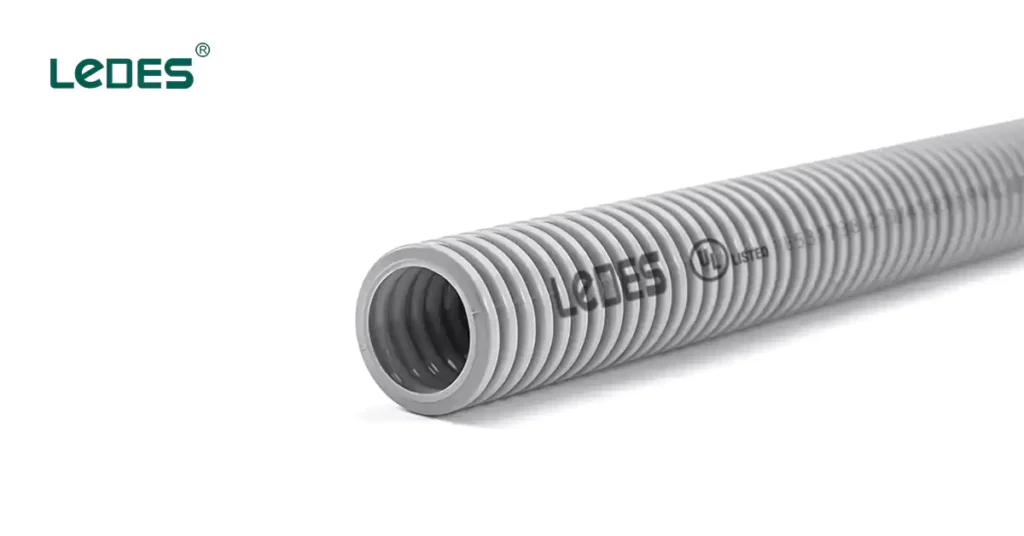
ENT는 벽, 바닥 또는 천장, 특히 주거용 및 상업용 건물에 빠르게 설치하는 데 자주 사용되는 유연한 골판지 플라스틱 도관입니다. 케이스에 넣거나 다른 보호 조치를 취하지 않는 한 충격이 심하거나 노출된 환경에는 적합하지 않습니다.
주요 특징:
특수 도구 없이도 유연하고 구부릴 수 있음
가볍고 스냅 잠금 피팅으로 설치가 더 빨라집니다.
부식성이 없고 금속성이 아니므로 콘크리트에 둘러싸여 습기가 많은 곳에 적합합니다.
일반적으로 벽 내부의 저전압 및 분기 회로 배선에 사용됩니다.
PVC 도관 사용의 이점
PVC 도관은 다음과 같은 여러 가지 장점을 제공하여 많은 응용 분야에서 선호되는 배선 방법으로 사용됩니다.
부식 저항성: 화학물질, 습기, 부식에 대한 뛰어난 내구성을 갖추고 있어 지하나 습한 환경에 이상적입니다.
안전: 비금속성, 비전도성으로 충격 위험을 줄이고 절연성을 향상시킵니다.
비용 효율성: 일반적으로 금속 도관 시스템보다 비용이 저렴하며 나사산 도구가 필요하지 않습니다.
설치 용이성: 가벼운 소재, 용매 용접 접합부(강성 PVC용), 스냅온 피팅(이비인후과용)은 수술 시간을 줄이는 데 도움이 됩니다.
내구성: 올바르게 설치하면 혹독한 환경을 견뎌낼 수 있는 내구성 있는 소재입니다.
PVC 도관 설치에 NEC가 중요한 이유
PVC 전선관은 분명한 장점을 제공하지만, 설비 전반의 안전성, 신뢰성 및 일관성을 보장하기 위해 미국 전기 규정(NEC)의 규제를 받습니다. NEC는 다음과 같이 규정합니다.
- PVC 도관 유형은 어디에서 어떻게 사용될 수 있습니까?
- 적절한 고정 및 지지 방법
- 피팅, 종료 및 전환에 대한 요구 사항
- 최소 매장 깊이 및 물리적 손상 구역의 보호
- 위험하거나 고온의 장소에서의 특별 고려 사항
NEC 지침을 따르면, 계약자와 엔지니어는 PVC 도관 설치가 최소 안전 기준을 충족하고, 검사를 통과하며, 장기적으로 안정적으로 기능하는지 확인할 수 있습니다.
PVC 도관에 대한 일반 NEC 요구 사항
폴리염화비닐(PVC) 도관은 다재다능함, 내구성, 비용 효율성으로 인해 전기 설비에 널리 사용되는 소재입니다. PVC 도관은 비금속성이며 가볍고 부식, 습기, 화학 물질에 강합니다. 이러한 특성으로 인해 주거, 상업 및 산업 프로젝트를 포함한 다양한 응용 분야에 적합합니다. 또한 PVC 도관은 뛰어난 전기 절연 특성을 제공하며 내장된 전기 케이블에 높은 수준의 보호 기능을 제공합니다.
일반 요구 사항
NEC는 PVC 도관이 안전한 전기 설비를 보장하기 위해 충족해야 하는 일반 요구 사항을 제시합니다. 이러한 요구 사항은 다음과 같습니다.
- UL 표준 준수: 전기 설비에 사용되는 PVC 전선관은 PVC 전선관용으로 특별히 설계된 UL(Underwriters Laboratories) 표준을 준수해야 합니다. 이를 통해 전선관이 필요한 안전 및 성능 기준을 충족함을 보장합니다.
- 환경적 적합성: PVC 전선관은 설치 환경에 적합해야 합니다. 실내, 실외, 습한 환경 또는 부식성 환경에 적합한 다양한 유형의 PVC 전선관이 제공됩니다. 적합한 유형을 선택하면 전선관 시스템의 수명과 신뢰성을 보장할 수 있습니다.
- 표시 및 식별: PVC 전선관은 제조업체명 또는 상표, 전선관 크기, 그리고 관련 전기 표준을 포함한 식별을 위한 적절한 표시를 해야 합니다. 이러한 표시는 전선관을 식별하고 필요한 표준을 준수하는지 확인하는 데 도움이 됩니다.
크기 및 채우기 요구 사항
PVC 도관의 적절한 크기 및 충전 요구 사항은 과열을 방지하고 충분한 와이어 용량을 보장하는 데 필수적입니다. NEC는 이와 관련하여 구체적인 지침을 제공합니다.
- PVC 도관의 크기는 1/2인치보다 크고 6인치보다 작아야 하며, 이 범위에 속하지 않는 크기는 사용해서는 안 됩니다.
- 채우기 한도 계산: 충전 한계는 도체의 단면적과 도관의 크기를 사용하여 계산됩니다. 이러한 한계를 준수하면 도체 과밀, 과열 및 잠재적 손상을 방지할 수 있습니다. 또한 도체 개수는 허용 충전율을 초과해서는 안 됩니다.
- 특별 고려 사항: 특정 용도에는 전선관 본체, 도체 절연 유형, 정격 감소율 등 특별한 고려 사항이 필요합니다. 이러한 요소는 충전 한계에 영향을 미칠 수 있으므로 전선관 크기 조정 시 반드시 고려해야 합니다.
설치 및 지원
PVC 도관의 적절한 설치 기술과 적절한 지원은 그 무결성을 보장하고 손상을 방지하는 데 중요합니다. NEC는 다음과 같은 요구 사항을 제공합니다.
- 안전한 고정 및 지지: PVC 전선관은 규정에 명시된 간격(일반적으로 90cm)으로 단단히 고정하고 적절히 지지해야 합니다. 이를 통해 전선관의 과도한 움직임, 늘어짐 또는 응력을 방지할 수 있습니다.
- 수직 및 수평 실행: PVC 전선관의 수직 및 수평 배선은 위치를 유지하고 처짐을 방지하기 위해 적절한 지지대가 필요합니다. 안정성을 확보하기 위해 적절한 간격으로 지지대를 설치해야 합니다.
- 지원 호환성: 전선관 지지대는 PVC 전선관과 호환되어야 하며 충분한 강도와 안정성을 제공해야 합니다. 지지대는 전선관 재질을 손상시키거나 구조적 무결성을 저해해서는 안 됩니다.
굽은 길과 교차로
PVC 도관의 적절하게 실행된 굽힘과 접합은 전기 시스템의 무결성을 유지하는 데 중요합니다. NEC는 다음 지침을 제공합니다.
- 최소 굽힘 반경: PVC 전선관은 제조업체에서 지정한 최소 굽힘 반경을 사용하여 구부려야 합니다. 이렇게 하면 전선관 손상을 방지하고 내부 도체에 과도한 응력이 가해지지 않습니다.
- 굽힘 도구 및 기술: 부드럽고 정확한 굽힘을 위해서는 적절한 굽힘 도구와 기술을 사용해야 합니다. 부적절한 굽힘은 도관의 성능에 영향을 줄 수 있는 꼬임, 납작함 또는 기타 변형을 초래할 수 있습니다.
- 접속함 및 전선관 본체: 접속함과 전선관은 적절한 크기를 가져야 하며, 접근이 용이해야 하고, 연결 및 배선 접속을 위한 충분한 공간을 제공해야 합니다. 이러한 구성 요소는 전선관 시스템의 무결성을 유지하는 데 중요한 역할을 합니다.
접지 및 본딩
PVC 도관 시스템의 적절한 접지 및 본딩은 전기적 안전에 필수적입니다. NEC는 다음 요구 사항을 설명합니다.
- 적절한 접지: PVC 전선관은 고장 전류 복귀를 원활하게 하고 전기적 안전을 보장하기 위해 적절히 접지되어야 합니다. 접지선은 NEC 지침에 따라 크기를 정하고 설치해야 합니다.
- 금속 인클로저 또는 도체와의 접합: PVC 도관을 금속 외함이나 도체와 함께 사용하는 경우 연속성을 유지하고 전위차를 방지하기 위해 접합 점퍼나 장치를 설치해야 합니다.
자세한 내용과 요구 사항은 공식 NEC 표준 파일을 확인하세요.
PVC 도관에 대한 NEC 요구 사항에 대한 심층적인 이해
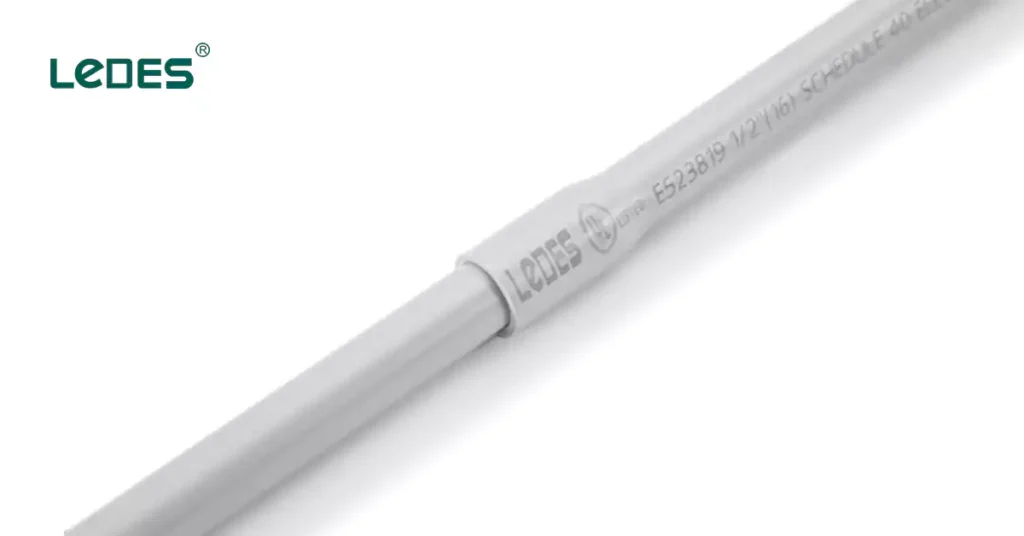
NEC 제352조 – 경질 폴리염화비닐(PVC) 도관
강성 폴리염화비닐 도관 (PVC)는 내구성, 내식성, 그리고 취급 용이성으로 인해 전기 설비에 널리 사용되는 비금속 레이스웨이 시스템입니다. 그러나 안전하고 적절한 사용을 보장하기 위해 미국 전기 규정(NEC)은 제352조에 따라 상세한 규정을 제공합니다. 이 요건에는 PVC 전선관의 허용 또는 금지 사항, 그리고 설치, 지지, 표시 및 보호 방법에 대한 내용이 포함됩니다. 아래는 NEC 352에 명시된 필수 조항의 세부 내용입니다.
강성 PVC 도관이 허용되는 경우
NEC에 따르면 경질 PVC 도관은 다양한 설치 환경에서 허용됩니다. 특히 다음과 같은 환경에서 허용됩니다.
노출된 작업과 숨겨진 작업.
땅속에 직접 매설하는 것을 포함한 지하 시설.
다른 NEC 조항에 따른 지휘자 지원.
콘크리트, 바닥 또는 벽에 내장하여 사용.
내화학성이 뛰어나 부식성 영향을 받는 장소에서 사용 가능
습기가 있거나 습한 환경.
지상 위치(햇빛 차단이라고 표시된 경우)
특히, 이 규정은 벽이 자주 침수되는 구조물에서도 방수 피팅을 사용하는 한 PVC 도관을 허용합니다.
강성 PVC 도관이 허용되지 않는 경우
경질 PVC 도관은 다재다능하지만 모든 용도에 적합한 것은 아닙니다. NEC 352.12는 다음과 같은 조건에서의 사용을 명시적으로 금지합니다.
심각한 물리적 손상이 발생할 수 있는 지역(보호되거나 둘러싸여 있지 않은 경우).
전선관의 정격 한도 이상의 온도에 노출되는 경우.
특별히 허가되지 않는 한 조명기구나 기타 장비를 지원하는 데 사용됩니다.
다른 NEC 조항에 의해 특별히 허가되지 않는 한 위험한(기밀로 분류된) 장소에 보관해야 합니다.
주변 온도가 표시된 정격을 초과하는 지역이나 열이나 화재로 인해 손상될 가능성이 있는 지역.
설치자는 재료의 오용을 피하기 위해 환경을 주의 깊게 평가해야 합니다.
습한 장소
PVC 도관의 가장 큰 장점 중 하나는 습하거나 습기가 많은 장소에도 적합하다는 것입니다. 세탁소, 식품 가공 공장, 세차장 등 물에 노출되기 쉬운 시설에 설치할 수 있습니다.
이러한 환경에서는 부속품과 접속함을 포함한 전체 배관 시스템을 조립하여 물이 스며들지 않도록 해야 합니다. 또한, 스트랩, 나사, 행거와 같은 모든 지지 장치는 부식 방지 처리가 되어 있거나 적절하게 보호되어야 합니다.
물리적 손상 보호
창고, 공공 시설 구역 또는 전선관이 부딪히거나 충격을 받을 수 있는 곳과 같이 물리적 보호가 필요한 경우, NEC는 전선관이 배선 시스템을 보호하기 위해 우수한 기계적 강도를 가져야 한다고 규정합니다.
도관 지원 요구 사항
적절한 지지는 정렬을 유지하고 시스템에 가해지는 스트레스를 방지하는 데 매우 중요합니다. NEC 352.30조는 경질 PVC 도관의 크기에 따른 지지에 대한 구체적인 지침을 제공합니다.
- 더 작은 크기(예: ½” ~ 1”)는 3피트(900mm)마다 지지되어야 하며 더 큰 크기는 6인치 도관의 경우 최대 8피트(2.5m)까지 더 긴 간격으로 지지될 수 있습니다.
- PVC 도관은 상자, 캐비닛 또는 인클로저와 같은 모든 종단 지점으로부터 900mm(3피트) 이내에 단단히 고정되어야 합니다.
더 자세한 정보는 다음을 확인하세요. 표 352.30(B):
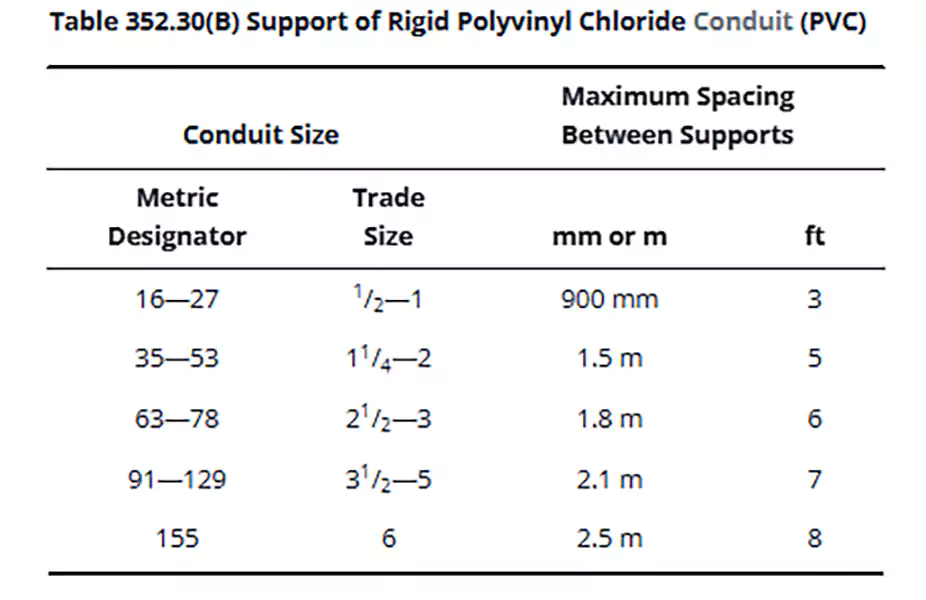
골조 부재를 관통하는 수평 도관은 간격이 NEC 요건을 충족하는 한 지지대로 간주될 수 있습니다. 이러한 규칙을 준수하면 안전을 보장할 뿐만 아니라 시스템이 팽창, 수축 및 장기 응력을 견디는 데 도움이 됩니다.
열팽창
PVC는 열가소성 소재이기 때문에 온도 변화에 따라 팽창과 수축이 크게 발생합니다. 긴 직선 구간에서 이러한 움직임은 적절히 관리하지 않으면 좌굴이나 접합부 분리로 이어질 수 있습니다. 이를 해결하기 위해 NEC는 온도에 따른 길이 변화가 1/4인치(6mm) 이상 예상될 경우 팽창 피팅 사용을 의무화하고 있습니다.
설치자는 설치 조건과 실제 사용 조건 사이의 주변 온도 차이를 고려해야 하며, 부속품이 상자나 캐비닛과 같은 두 고정 지점 사이에 설치되도록 해야 합니다. 그렇지 않으면 시스템 무결성이 손상되고 값비싼 수리가 발생할 수 있습니다.
접지 요구 사항
경질 PVC 전선관은 비금속 시스템이므로 그 자체로는 접지 경로 역할을 하지 않지만, 미국 전기 규정(NEC)에서는 이러한 유형의 전선관을 사용할 때 적절한 접지를 보장하기 위한 구체적인 요건을 명시하고 있습니다. NEC 352.60에 따르면, 장비 접지가 필요한 경우, 안정적인 고장 복귀 경로를 제공하기 위해 PVC 전선관 내부에 별도의 접지선을 설치해야 합니다.
마킹 요구 사항
모든 강성 PVC 도관은 적절한 식별 및 규정 준수를 보장하기 위해 명확하게 표시되어야 합니다.
표시는 최소 3미터(10피트)마다 나타나야 합니다.
재료 유형을 표시해야 합니다(시각적으로 명확하게 알 수 없는 경우).
지상 설치의 경우 표시는 영구적이어야 합니다.
지하 전용 도관의 경우, 표시는 설치 시점까지 읽을 수 있어야 합니다.
선택적인 표면 표시에는 다음이 포함될 수 있습니다.
야외 노출에 적합한 "햇빛 저항성"
저연기 발생 응용 분야를 위한 "제한된 연기"
이러한 표시는 검사원과 설치자가 적절한 사용 및 성능을 확인하는 데 도움이 됩니다.
NEC 제362조 – 전기 비금속 튜빙(ENT) 요구 사항
이비인후과 도관 현대식 배선 설비, 특히 상업 및 주거용 건축에 널리 사용되는 유연하고 가벼운 비금속 레이스웨이 시스템입니다. 설치가 간편하고, 내부식성이 뛰어나며, 좁거나 복잡한 건물 배치에도 쉽게 적응할 수 있어 높은 평가를 받고 있습니다. 미국 전기 규정(NEC) 제362조는 ENT의 안전하고 효과적인 사용을 위한 포괄적인 규정을 명시하고 있으며, 여기에는 적용 범위, 허용 용도, 시공 규격 및 표시 요건이 포함됩니다.
이비인후과를 사용할 수 있는 곳
저층 건물(3층 이하): 이비인후과 검사는 열린 공간(노출된 공간)과 숨겨진 공간(은폐된 공간) 모두에서 허용됩니다.
고층 건물(3층 이상): 건물 전체에 스프링클러가 설치된 경우를 제외하고, 방화 재료로 보호된 경우에만 ENT 검사가 허용됩니다.
매달린 천장 위: Allowed when the ceiling offers basic fire protection, or in sprinklered buildings.
Concrete applications: ENT can be encased in poured concrete or laid on sand within concrete slabs, if compatible fittings are used.
Dry and damp areas: ENT can be used in these locations if it’s listed for such use.
Wet areas: Permitted only if ENT and its fittings are approved for wet conditions.
Chemical/corrosive environments: Can be used if specially rated to withstand such exposure.
Where ENT Cannot Be Used
Outdoors in direct sunlight or where subject to physical damage (unless specially approved).
In unprotected high-rise areas without fire-rated coverings.
In hazardous (classified) locations unless clearly listed for that use.
Physical and Electrical Limitations
ENT is not permitted in trade sizes larger than 2½ inches (metric designator 63). It must also be installed using approved fittings and couplings to ensure joint integrity and system continuity.
The code permits ENT to be used with conductors or cables rated for higher temperatures only if those conductors are not operated above the temperature rating of the ENT. This provides some flexibility in cable selection while maintaining the safe thermal limits of the raceway system.
Additionally, ENT is not designed to support mechanical loads. It should not be used to hang or support luminaires, fans, or other equipment unless specifically approved for such applications.
ENT Support Requirements
Proper support is critical to maintaining the structural integrity and functionality of ENT systems. According to NEC requirements:
- Support Intervals: ENT must be securely supported within 3 feet (900 mm) of each box, fitting, or enclosure, and at intervals not exceeding 3 feet (900 mm) throughout its run.
- Horizontal and Vertical Runs: Both horizontal and vertical ENT installations must follow these support spacing guidelines unless otherwise permitted by the listing.
- Securing Devices: Use only approved straps, clamps, or other fittings specifically designed for ENT. These must not damage the tubing and should maintain mechanical protection.
- Embedded or Concealed Runs: When ENT is encased in concrete or concealed within walls, floors, or ceilings, additional support is not required at those points.
Grounding Considerations for ENT
Because ENT is nonmetallic and nonconductive, it does not provide an equipment grounding path. Therefore:
- A separate grounding conductor must be included inside the ENT when used to supply grounded (earthed) equipment.
- All metal boxes, enclosures, or devices connected to the ENT must be properly grounded using this separate conductor.
마킹 요구 사항
To ensure traceability and compliance:
ENT must be clearly and durably marked at least every 10 feet (3 meters).
Markings must include the material type and any limited smoke classification, if applicable.
When ENT is used in prewired assemblies, conductor type, size, and quantity must be shown on a printed tag or label attached to both ends of the tubing and on its packaging.
Special Occupancies and PVC Conduit Requirements

Beside general wiring methods for electrical systems, Chapter 5 of the NEC focuses on special environments that require more stringent safety considerations due to elevated risks. These include hazardous locations, health care facilities, recreational vehicles, agricultural buildings, and more. For PVC conduit installations, understanding the additional requirements outlined in Chapter 5 is critical to ensuring compliance and safety in these specialized settings, here are some of the special installation locations.
위험 장소
In areas classified as hazardous due to the presence of flammable gases, vapors, or dusts, such as chemical plants or grain silos, conduit systems must provide robust protection against ignition sources.
PVC conduit may be restricted or permitted only under specific conditions in these environments:
- It is typically not permitted in Class I, Division 1 locations where explosive gases may be present under normal operation.
- In Division 2 areas, limited uses of PVC conduit may be allowed if it is buried or encased in concrete and properly sealed.
- Rigid nonmetallic conduit must be specifically listed and marked for use in hazardous environments if permitted.
Health Care Facilities
In hospitals, dental offices, and similar environments, wiring systems must meet strict standards to ensure continuous, reliable operation of life-support and diagnostic equipment. PVC conduit may be used in certain non-patient care areas but is often restricted in patient care spaces, where metallic raceways offering superior grounding and shielding may be required.
Key considerations:
Grounding continuity is crucial—since PVC is nonmetallic, a separate equipment grounding conductor must be installed.
Mechanical protection 그리고 fire resistance also matter, especially where conduits pass between floors or through fire-rated assemblies.
Recreational Vehicles Parks and Mobile Homes
PVC conduit is often used for underground distribution and service entrance conductors in RV parks and mobile home communities.
- It must be listed for direct burial, and proper transitions to above-ground enclosures or pedestals are required.
- Installation must comply with bending radius, conduit fill, and sealing requirements to prevent moisture ingress.
- Conductors must include an EGC, since PVC does not provide a grounding path.
Agricultural Buildings
Moisture, dust, ammonia, and corrosion are persistent hazards in agricultural facilities such as barns, poultry houses, and dairy operations. NEC Article 547 allows PVC conduit in these areas due to its resistance to chemicals and corrosion, provided it is watertight and securely installed.
All conduit systems must prevent moisture intrusion—a requirement especially important in wash-down areas.
Corrosion-resistant fittings and supports are mandatory.
PVC must be mechanically protected where physical damage is likely, often by using Schedule 80 conduit.
Other Special Conditions in NEC
As modern electrical systems evolve to include emergency power, energy storage, and communication infrastructure, the National Electrical Code (NEC) provides dedicated guidelines in Chapter 7 and Chapter 8. These chapters outline the special conditions and system-specific requirements that often affect how PVC conduit systems, including rigid PVC and ENT, must be designed and installed.
Emergency & Energy Storage Systems
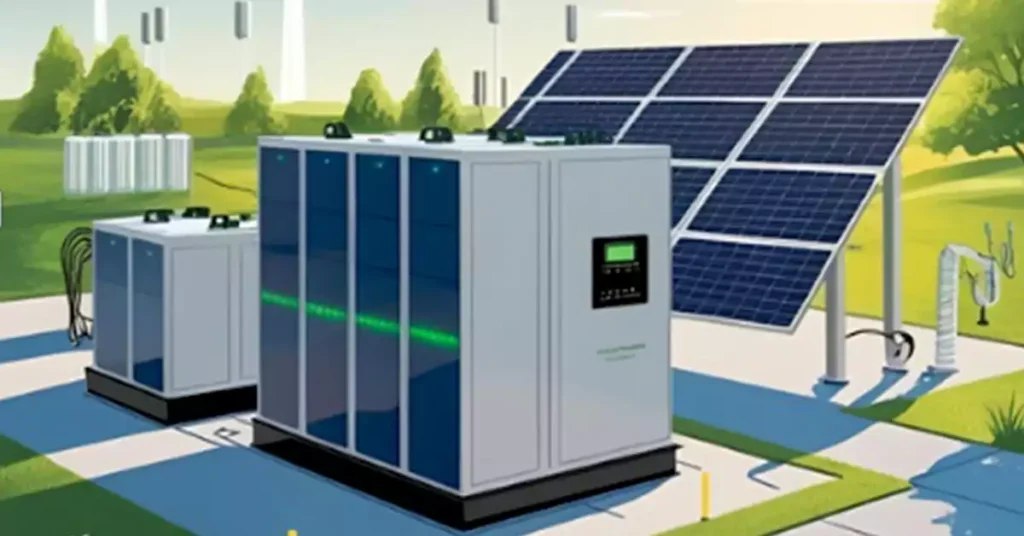
Emergency Systems (Article 700)
Emergency systems provide power during outages to support critical operations such as emergency lighting, fire alarms, and communication systems.
- PVC conduit can be used in emergency system installations, but only if the system integrity is maintained under emergency conditions.
- Rigid PVC must be installed with attention to mechanical protection and separation from normal systems, and it must comply with any fire barrier requirements in the space.
Important Note: Emergency wiring must be segregated from other systems and clearly identified. PVC can help with color-coded raceways for identification but cannot serve as an equipment grounding path—a separate equipment grounding conductor (EGC) is always required.
Energy Storage Systems (ESS) (Article 706)
With the rise of battery energy storage systems (BESS), safe wiring becomes essential—especially for systems using lithium-ion or other advanced chemistries.
- PVC conduit is permitted for many ESS installations, especially in indoor or underground raceways.
- Conduits must be properly sized for heat dissipation and include EGCs.
- In many cases, local building/fire codes may impose additional rules—such as requiring metallic conduit or fire-rated enclosures for battery rooms—so PVC must be used judiciously and in compliance with all applicable standards.
전문가 팁: Want to know the different codes for ESS in the United States, Canada, and Australia? This article discusses the details of the Energy Storage System and the relevant code compliance in North America and Australia.
Communication Systems - Chapter 8
Chapter 8 covers systems such as telephone, internet, TV, and broadband—often referred to as low-voltage or extra-low-voltage systems.
PVC Conduit for Communications
Rigid PVC conduit is commonly used to protect communication cables—particularly in underground or outdoor installations—due to its corrosion resistance and cost-effectiveness.
ENT can also be used in concealed indoor spaces if it meets the routing and bend radius requirements for communication cabling.
Key considerations:
Communication raceways must be segregated from power wiring to prevent electromagnetic interference.
PVC raceways for communication cables should be marked and routed clearly, especially when installed in plenum or riser spaces (note that LSZH or plenum-rated cable may be required instead of special conduit).
PVC used in communication pathways must still comply with bend radius, fill capacity, and support spacing requirements.
전문가 팁: Need to know more about communication conduit types and codes? You can read this expert guide to comms conduits.
Ledes PVC Conduit Solutions
Ledes PVC conduit systems are engineered to meet the demands across a wide range of installation environments, from general, special to communication system applications. Offering durability, compliance, and safety in even the most demanding applications.
강성 PVC 도관
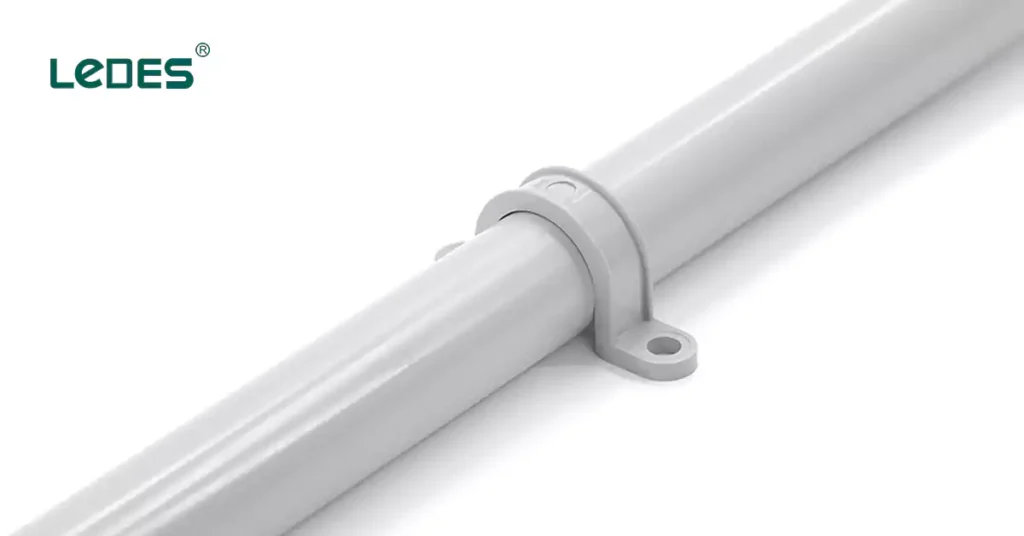
Ledes rigid PVC conduits are designed and manufactured to comply with relevant NEC articles, including Article 352 for Rigid PVC Conduit. These products are:
- UL 인증, with third-party testing to meet UL 651 standards.
- Manufactured to meet flame resistance, crush resistance, and impact resistance thresholds required for indoor and outdoor installations.
- Offered in both Schedule 40 and Schedule 80, accommodating buried installations, exposed applications, and high mechanical stress environments.
- Available with markings every 3 meters (10 feet) as per NEC for traceability and identification.
These features make Ledes PVC conduits a reliable choice for general-purpose wiring in residential, commercial, and industrial buildings, supporting both concealed and exposed applications, including underground systems, underground and embedded concrete installations.
전기 비금속 튜브(ENT)
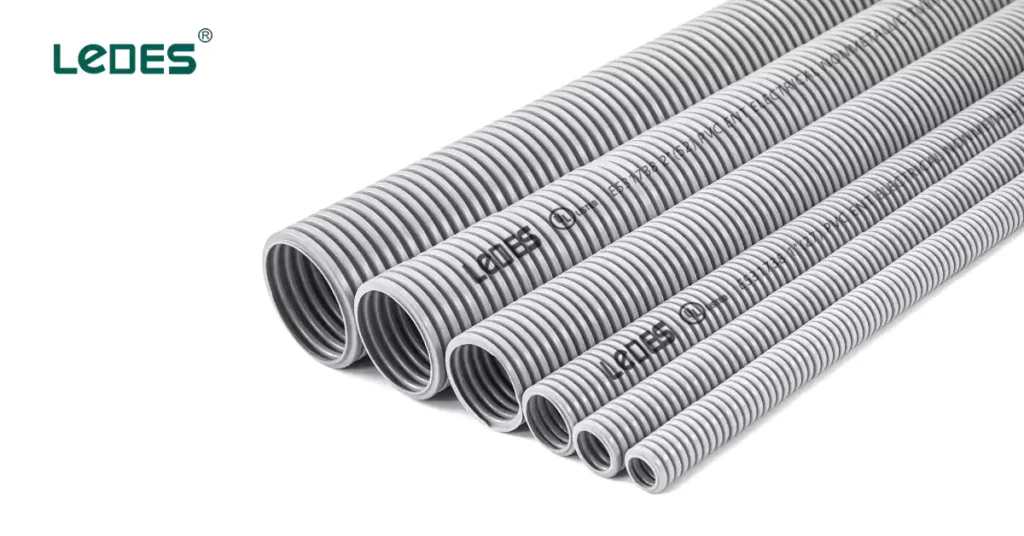
Ledes also provides a full line of Electrical Nonmetallic Tubing (ENT) designed for compliance with NEC Article 362. Ledes ENT solutions are:
- UL 1653 certified for flame propagation, crushing, and bending performance.
- Lightweight and flexible, enabling quick installation in wall cavities, ceiling spaces, and floor assemblies.
- Designed for use above suspended ceilings or within fire-rated walls and slabs, where ENT is permitted by NEC under thermal protection or sprinkler system conditions.
- Suitable for installation in concrete slabs on grade.
Ledes ENT is especially useful in multi-family, healthcare, and light commercial settings where flexibility, speed, and fire-rated construction are necessary.
결론
Understanding and applying the National Electrical Code (NEC) requirements for PVC conduit systems, such as Rigid PVC Conduit and Electrical Nonmetallic Tubing (ENT) are essential for safe, compliant, and long-lasting electrical installations. From general installation rules and permitted uses to specialized requirements for emergency systems, energy storage, and communication circuits, each aspect of the NEC is designed to ensure safety, functionality, and adaptability across diverse environments.
Ledes’ PVC conduit solutions are developed with these standards in mind. Whether it’s fire-resistance for buildings with stringent protection needs, corrosion resistance for chemical environments, or system compatibility for modern communication and energy infrastructures, Ledes provides reliable products that meet both code requirements and practical demands.
Looking ahead, as building systems evolve with growing emphasis on energy efficiency, smart infrastructure, and safety, it is more important than ever to align conduit system choices with NEC guidance. Thoughtful conduit selection not only ensures code compliance but also contributes to long-term reliability, simplified maintenance, and future-ready installations.
By combining a deep understanding of the NEC with proven product performance, electrical professionals can design systems that are both technically sound and ready for tomorrow’s challenges.
자주 묻는 질문
PVC 배관을 지하에 매설할 수 있나요?
네, PVC 도관은 지하 설치에 적합합니다. 그러나 매설에 대해 특별히 평가 및 승인을 받아야 합니다. 매설 깊이와 콘크리트 덮개와 같은 필요한 보호 조치는 지역 코드 및 규정을 준수해야 합니다.
PVC 배관은 실내와 실외 설치에 모두 사용할 수 있나요?
네, PVC 도관은 실내 및 실외 설치에 적합한 유형으로 제공됩니다. 그러나 수명과 성능을 보장하기 위해 특정 환경 조건에 따라 적절한 유형을 선택하는 것이 중요합니다.
PVC 전선관에 허용되는 굽힘 횟수에 제한이 있습니까?
Yes, the National Electrical Code (NEC) places a restriction on the number of bends in a run of PVC conduit (as well as other types of conduit).
According to NEC 352.26 for Rigid PVC Conduit, and similar rules for other raceway types:
The total number of bends between pull points (e.g., boxes, conduit bodies, or other access points) must not exceed 360 degrees.
This means:
You can have up to four 90-degree bends, or
Any combination of bends that does not exceed 360 degrees total.
PVC 도관을 고온의 장소에서 사용할 수 있나요?
PVC conduit can be used in areas with elevated temperatures, but there are important limitations and considerations.
Standard rigid PVC conduit is typically rated for use up to 50°C (122°F) ambient temperature.
Some types may be rated for higher temperatures (e.g., 90°C [194°F] for the conductors inside), but the conduit itself may soften or lose strength at high temperatures.
PVC 도관은 부식성 환경에 적합합니까?
PVC 도관은 많은 일반적인 부식성 물질에 대한 내성이 있으며 광범위한 환경에 적합합니다. 그러나 부식성이 강한 환경에서는 제조업체의 사양을 참조하고 PVC 코팅 강성 금속 도관 또는 기타 부식 방지 옵션과 같은 대체 도관 재료를 고려하는 것이 좋습니다.
PVC 도관에 대한 특정 색상 코딩 요구 사항이 있습니까?
네, NEC는 다양한 유형의 전선관에 색상 코드를 의무화하고 있습니다. 예를 들어, 회색 PVC 전선관은 전기 시스템에 자주 사용되고, 주황색 PVC 전선관은 일반적으로 통신 및 데이터 애플리케이션에 사용되며, 빨간색은 화재 경보 시스템이나 고압선에 사용됩니다.
PVC 도관을 고전압 응용 분야에 사용할 수 있나요?
PVC 전선관은 일반적으로 저전압 용도에 사용되지만, 특히 최대 600V 시스템의 경우 일부 고전압 용도에도 적합할 수 있습니다. 600V 이상의 전압을 사용하는 경우, 해당 전압 등급에 맞게 등재 및 식별된 전선관을 사용하고, 특히 NEC 300조 및 352조를 준수하여 설치해야 합니다.


